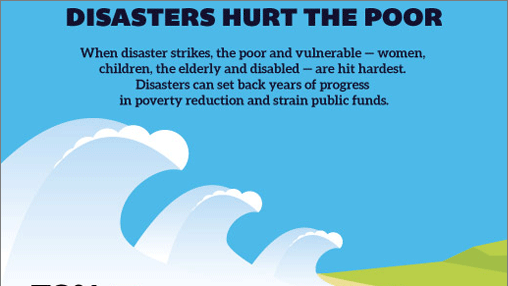KEY FINDINGS
- Disasters present a serious development challenge for the East Asia and Pacific region.
- 61% of global losses from disasters was sustained by the region in the past 20 years.
- 40% of floods worldwide happened in the region in the past 30 years.
- More than 1.6 billion people were affected by disasters in the region since 2000.
- Globally, economic losses from disasters have been increasing at a quickening pace, with costs 15 times higher in the 1990’s than in the 1950’s. The year 2011 was the costliest on record. In the first 9 months, losses in East Asia Pacific amounted to $259 billion, which was 80% of the global total.
- In relative terms, the Pacific Island countries are the most affected globally, with average annualized losses estimated for Vanuatu and Tonga at 6.6% and 4.4% of GDP respectively.
- Rapidly growing East Asian cities are becoming increasingly vulnerable to disasters, with a greater concentration of people and assets in urban areas. Unplanned or poorly planned urbanization puts communities at risk, particularly through informal settlements and inadequate land management.
- Developing countries in the region will be exposed to large fiscal impacts on public expenditure, as governments shoulder an increasing financial responsibity for post-disaster recovery and reconstruction.
- Policy makers can make a significant difference to ensure that progress in development and poverty reduction are not lost by acting now to build resilience. Investing in disaster preparedness, from strengthening hazard forecast services to restoring natural ecosystems, can be surprisingly cost-effective, greatly reducing the impact of natural hazards.
- In the short-term, investing in hazard forecasting and hydrometeorological early warning systems can have a high cost-benefit ratio with immediate and significant payoffs. Strengthening legislation and promoting institutional coordination, promoting disaster risk reduction in community-based development programs are also beneficial.
- In the medium- to long-term, striking the right balance between investments in structural and non-structural measures is key. This includes “gray” concrete and cost-effective “green” infrastructure, such as establishing mangroves, wetland buffers and coastal restoration. Expanding early warning systems based on real-time data and forecasting is also important, as well as developing a comprehensive disaster risk-financing strategy, and social protection systems that can be scaled up in the event of a disaster.
- In the long-term, urbanization should be managed through systematic use of risk assessments, risk-aware urban planning and development, and robust decisions that take into account disaster and climate risks and uncertainties.

